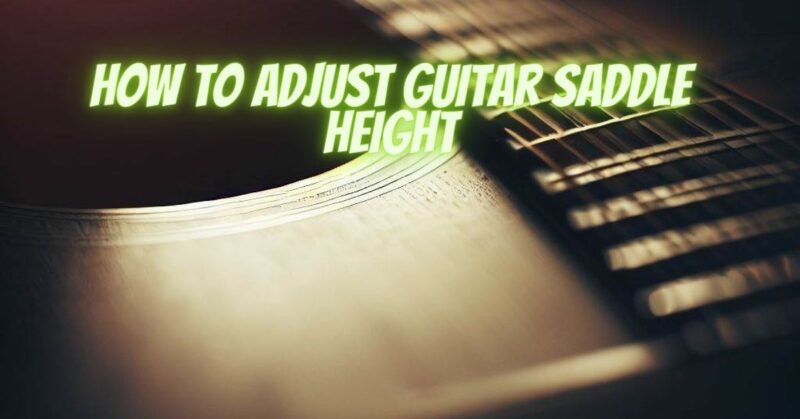For guitarists seeking to fine-tune their instrument’s playability and tone, adjusting the saddle height is a valuable skill. The saddle, a small but crucial component located on the bridge of the guitar, influences string action, intonation, and overall tone. In this article, we’ll explore the steps and techniques for adjusting guitar saddle height, empowering you to optimize your instrument’s performance according to your preferences.
Why Adjust Saddle Height?
Before diving into the adjustment process, it’s important to understand why you might want to adjust your guitar’s saddle height:
- Action: Saddle height directly affects string action, which is the distance between the strings and the fretboard. Adjusting saddle height allows you to tailor the action to your playing style and comfort.
- Intonation: Proper saddle height is crucial for maintaining accurate intonation across the fretboard. Adjustments can ensure that your guitar plays in tune as you move up and down the neck.
- Tone: Saddle height can influence the tonal characteristics of your guitar, including brightness, warmth, and sustain. Fine-tuning saddle height can help you achieve your desired sound.
Tools and Materials Needed
To adjust your guitar’s saddle height, you’ll need the following tools and materials:
- Guitar Saddle Wrench: This specialized tool allows you to remove and adjust the saddle.
- Ruler or Gauge: A precise measurement tool is essential for maintaining even saddle height across all strings.
- Guitar Tuner: To check and adjust intonation accurately, a reliable guitar tuner is essential.
- Sandpaper or Files: These are useful for minor adjustments to the saddle’s height.
Step-by-Step Guide to Adjusting Saddle Height
Here’s a step-by-step guide to adjusting your guitar’s saddle height:
- Prepare Your Workspace: Find a clean, well-lit workspace where you can comfortably work on your guitar. Ensure your guitar is properly supported and stable.
- Loosen Strings: To access the saddle, you’ll need to loosen the strings. Use your guitar tuner to bring the strings to a lower pitch.
- Remove the Saddle: Carefully use a guitar saddle wrench to remove the saddle from the bridge. Keep track of any shims that may be under the saddle.
- Measure Existing Height: Using a ruler or gauge, measure the current height of the saddle. Note the measurements for reference.
- Adjust the Saddle Height: To raise the saddle, carefully sand the bottom with fine-grit sandpaper or use a file. To lower the saddle, remove material from the top. Make small adjustments and check the height frequently to avoid overdoing it.
- Maintain a Flat Bottom: Ensure that the bottom of the saddle remains flat to maintain proper string-to-surface contact.
- Check String Action: After making adjustments, reinsert the saddle into the bridge. Tune the guitar to pitch and assess the string action. Make further adjustments as needed to achieve your desired action.
- Check Intonation: Play each string at the 12th fret and check if the pitch matches the open string. Adjust the saddle position to correct any intonation issues.
- Fine-Tuning: Play your guitar and assess the tone and playability. Make minor adjustments as necessary to achieve your preferred sound and feel.
- Re-Tune: After completing all adjustments, re-tune your guitar to pitch.
Adjusting guitar saddle height is a valuable skill that allows you to customize your instrument to suit your playing style and tonal preferences. With the right tools, materials, and a systematic approach, you can achieve the perfect saddle height, optimizing your guitar’s playability and sonic capabilities. Whether you’re a seasoned guitarist or a beginner, mastering this skill can greatly enhance your musical experience and creativity.


